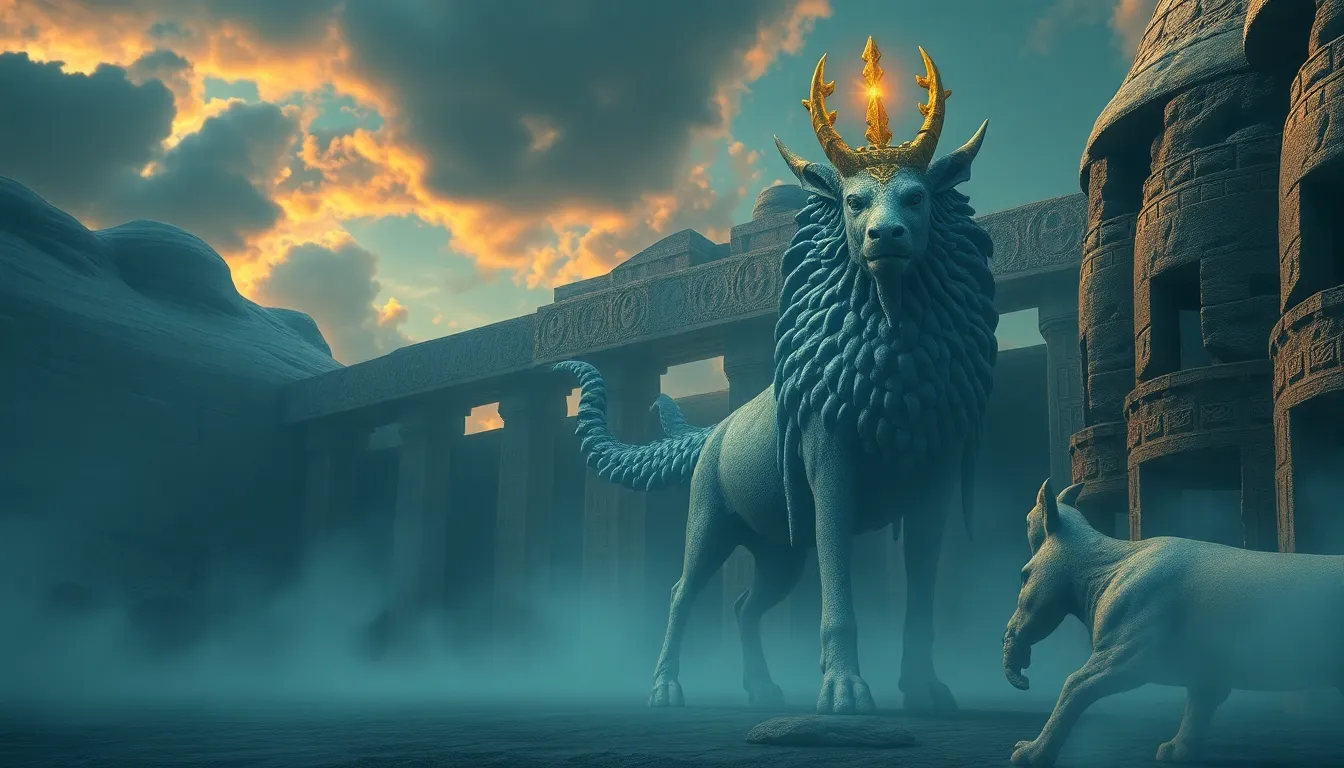The Lore of the Land: Exploring the Spirits of the Babylonian Lamassu
I. Introduction to Lamassu
The Lamassu is a fascinating figure from the ancient Babylonian culture, representing a unique blend of human, animal, and divine traits. These mythical creatures are often depicted as winged bulls or lions with human heads, symbolizing strength, protection, and divine power. In ancient Mesopotamia, they played a crucial role in art and mythology, serving as guardians of cities and palaces.
Physically, Lamassu are characterized by their imposing size and distinctive features. Typically depicted with the body of a bull or lion, large wings, and a human head, they exude a sense of majesty and authority. Their presence was believed to ward off evil spirits, making them essential in the architecture of temples and palaces.
In the context of Mesopotamian mythology, Lamassu were not only guardians but also symbols of divine protection. They often appeared at the entrances of important buildings, serving both a protective and decorative purpose, and embodying the duality of fierce power and benevolent protection.
II. Historical Context of the Lamassu
The origins of the Lamassu can be traced back to ancient Near Eastern art, with their first appearances dating to the early periods of Mesopotamian civilization. Initially, they were simple in design, but over time, their representations evolved, becoming more elaborate and detailed.
Throughout different periods, particularly during the Assyrian Empire, Lamassu became more prominent in architectural designs. They were often sculpted in stone and placed at the entrances of palaces and temples, symbolizing the power of the king and the divine protection bestowed upon the realm.
Archaeological discoveries of Lamassu statues and reliefs have shed light on their significance. Excavations in places like Nineveh and Nimrud have uncovered numerous examples, highlighting their role in ancient society. These findings have not only informed our understanding of Lamassu but also of the cultural and political landscapes of Mesopotamia.
III. Symbolism and Meaning of the Lamassu
Lamassu are imbued with rich symbolism, primarily recognized for their protective qualities. Positioned at strategic locations, they were believed to guard against malevolent forces, ensuring the safety of both the physical and spiritual realms.
- Protective Guardians: Their primary role was to act as guardians of cities and temples, warding off evil spirits and intruders.
- Connection to Kingship: The presence of Lamassu at royal entrances symbolizes the divine authority of the king, reinforcing the idea that the monarchy was sanctioned by the gods.
- Hybrid Form Interpretation: The combination of man, bull, and bird in their form represents the convergence of various strengths—intellect, power, and freedom—making them ideal protectors.
IV. The Lamassu in Babylonian Religion
In Babylonian religion, the Lamassu were closely related to various deities and mythological figures. They were often seen as intermediaries between the gods and humans, emphasizing their importance in the spiritual hierarchy.
Rituals and practices involving Lamassu often included offerings and prayers at their feet, as people sought protection and blessings. The belief in their power extended to everyday life, as households would have smaller representations of Lamassu to safeguard their homes.
The influence of Lamassu on local spirituality was profound, as they became integral to the cultural identity of the people. The reverence for these creatures reflected a broader understanding of protection and divine presence in the lives of ancient Babylonians.
V. Artistic Representations of Lamassu
The artistic representations of Lamassu are vast and varied, primarily seen in sculptures and reliefs. These works showcase the intricate craftsmanship of ancient Mesopotamian artisans, who utilized different materials such as stone, alabaster, and clay.
- Sculptures: Large-scale Lamassu sculptures were often placed at the entrances of important buildings, showcasing their protective role.
- Reliefs: Smaller reliefs adorned walls within temples and palaces, depicting Lamassu in various poses, emphasizing their divine nature.
- Material and Style Variations: Different epochs saw changes in style—from the more rigid forms of the Old Babylonian period to the dynamic and expressive styles of the Assyrian Empire.
When comparing Lamassu to other protective figures in neighboring cultures, similarities can be observed, yet each culture infused their protective beings with unique traits and significance, reflecting their distinct beliefs and values.
VI. The Lamassu in Modern Culture
In recent years, there has been a revival of interest in ancient Mesopotamian mythology, with the Lamassu at the forefront. Scholars, artists, and enthusiasts alike have sought to revisit and reinterpret these ancient figures in the context of modern culture.
Contemporary art and literature have embraced the Lamassu, often using them as symbols of resilience and protection in a world that still grapples with conflict and insecurity. Their representation in various media serves to highlight the continuing relevance of ancient mythologies.
Moreover, the influence of Lamassu can be seen in modern architecture and design. Elements reminiscent of Lamassu have found their way into new structures, symbolizing a connection to cultural heritage while embracing contemporary aesthetics.
VII. Preservation and Legacy of the Lamassu
The preservation of Lamassu artifacts has become increasingly vital, particularly in light of conflicts that threaten cultural heritage. Efforts to protect and restore these ancient treasures are underway, with international organizations and governments working towards their conservation.
The impact of war on cultural heritage has been devastating, yet initiatives aimed at restoring Lamassu sculptures and sites continue to gain momentum. These efforts not only safeguard the physical artifacts but also foster a deeper appreciation of the cultural narratives they embody.
Educational initiatives focused on the Lamassu and Mesopotamian history aim to promote understanding and appreciation of ancient civilizations. By engaging the public and encouraging scholarly research, these programs help keep the legacy of the Lamassu alive for future generations.
VIII. Conclusion
In summary, the Lamassu holds a significant place in the annals of history and culture, embodying the complexities of ancient Babylonian beliefs. Their role as protective figures, symbols of kingship, and artistic representations reflect a rich tapestry of meaning that resonates through the ages.
As we reflect on the enduring legacy of the Lamassu, it becomes clear that these mythical creatures continue to inspire and inform our understanding of ancient mythologies. The call for further exploration and appreciation of these ancient spirits is not only a tribute to their historical significance but also an invitation to connect with the rich cultural heritage of humanity.



